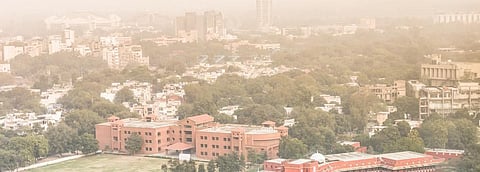Stubble burning forces Delhi to breathe ‘poor’ air
Stubble burning in Punjab and Haryana and other meteorological factors pushed Delhi’s air quality level down to ‘poor’ in the last four days.
On October 14, 2019, the air quality index (AQI) in the national capital was at 280, the upper end of ‘poor’ category, according to the Centre-run System of Air Quality and Weather Forecasting.
In at least three areas — Anand Vihar, Dwarka, and Vivek Vihar — the air quality was already in ‘very poor’ category, showed data from Central Pollution Control Board (CPCB).
An AQI between 0-50 is marked as ‘good’, 51-100 ‘satisfactory’, 101-200 is ‘moderate’, 201-300 ‘poor’, 301-400 ‘very poor’, and 410-500 ‘severe’.
Stubble burning is responsible for around 10-15 per cent of this pollution load, according to Indian Institute of Tropical Meteorology (IITM) scientists. While particulate matter (PM) 10 was at a moderate 208 microgramme per cubic metre (ug/m3), PM 2.5 was at 114 ug/m3 in ‘poor’ category.
“Around 10-15 per cent of this PM 2.5 is due to crop residue burning. The winds are northwesterly currently, coming from Punjab, Haryana and bringing pollution to Delhi,” said Sachin Ghude, scientist, IITM.
“Since the weather conditions are stable and wind speed is less in Delhi, the pollutants are concentrated and not getting dispersed,” added the scientist.
There has been a three-fold increase in farm fires around Delhi in the last couple of days. The IITM recorded 12 fires on October 7. This number rose to 46 the next day, 146 on October 11, and 172 on October 12.
“It is likely to increase further since the season has started now," said Ghude.
Every year between October and November, the air quality in Delhi and neighbouring states deteriorates as farmers burn the residue after harvesting paddy to clear the fields and make way for the sowing of wheat. This is despite the fact that there’s a ban on burning agricultural residue.
However, this year, the situation was relatively better in the first half of October when the city saw more ‘satisfactory’ air quality days. The improvement was attributed to both meteorological factors and efforts to monitor air pollution and spread awareness.
The quality of air has deteriorated to ‘poor’ in Punjab and Haryana as well. While monitoring stations in cities in Punjab show ‘moderate’ air quality levels, one in Amritsar, which sees a majority of stubble burning cases, recorded ‘poor’ air. Haryana’s Ambala and Karnal too breathe ‘poor’ air.
From October 15, the Graded Response Action Plan (GRAP) to combat air pollution will come into force in the Capital.

